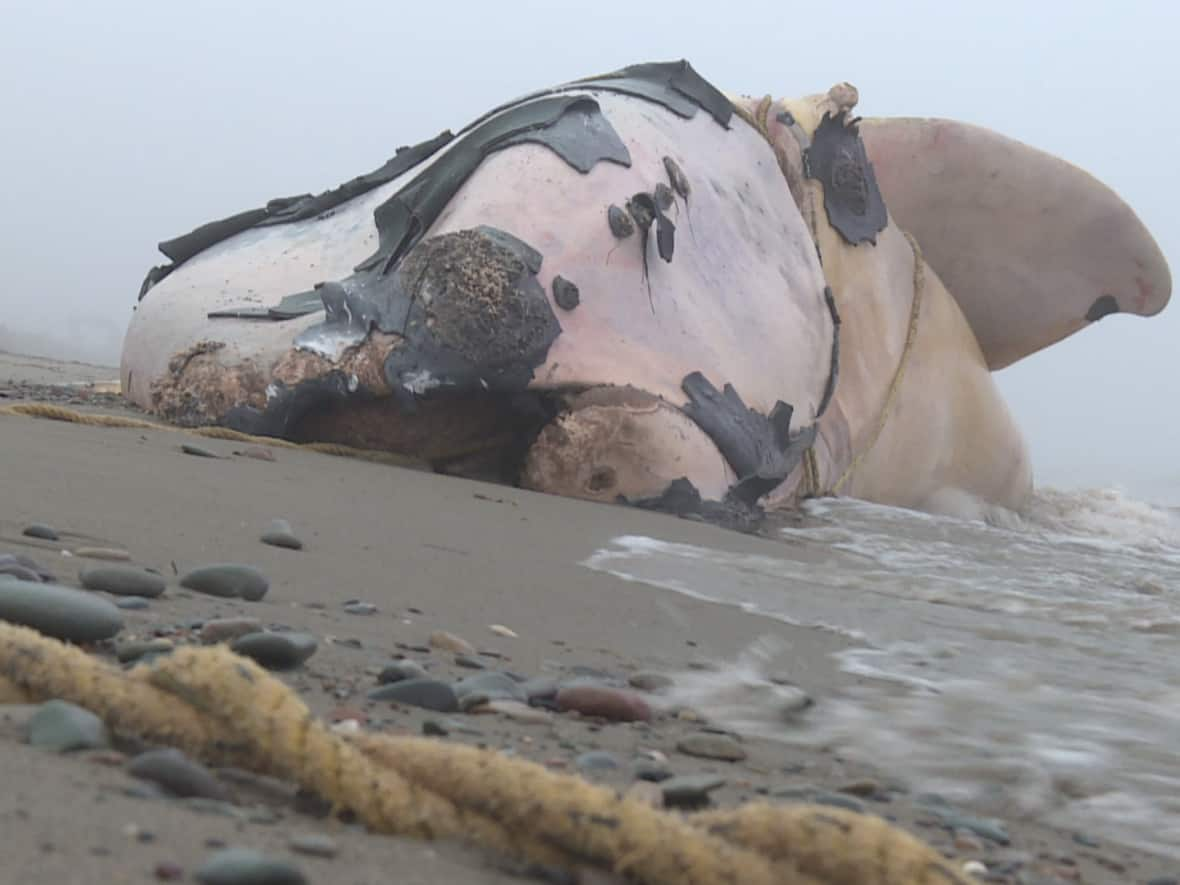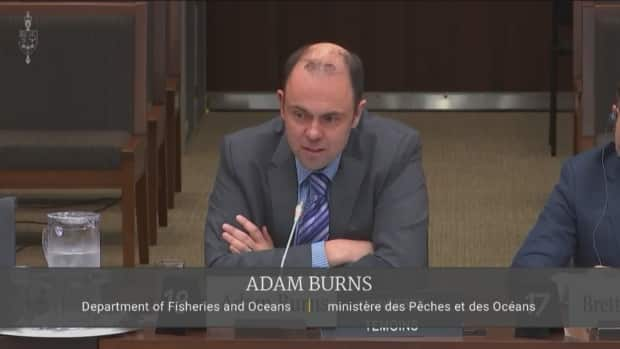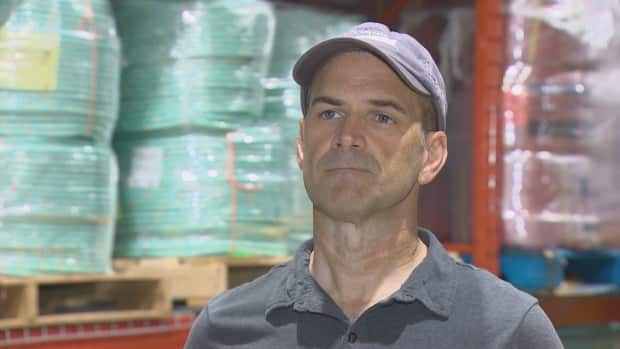Canada disputes U.S. environmentalist claims on right whale protections

The federal government is challenging charges from U.S. environmentalists that it's not doing enough to protect critically endangered north Atlantic right whales, claiming measures taken since 2018 have reduced the risk of entanglements in the critical Gulf of St. Lawrence snow crab fishery by 82 per cent.
The new statistic was unveiled by Fisheries and Oceans Canada (DFO) at a parliamentary committee meeting held after the latest environmental condemnation — a red rating from the Monterey Bay Aquarium Seafood Watch — recommending consumers avoid buying Canadian snow crab and lobster because of the risk posed to right whales from entanglements in fishing rope.
"We disagree with it," said Adam Burns, an acting assistant deputy minister.
Burns was repeatedly questioned about the red rating on Sept. 27, the first of six meetings planned on right whales by the DFO committee.
"Canada worked to ensure that [Seafood Watch] had the necessary information to make a fair and balanced assessment of Canada's management regime. Unfortunately, we do not believe that they took all of that into consideration in their findings and did not recognize the differences in Canada's regime from those in the U.S.," Burns testified.
DFO is not disputing that north Atlantic right whales are imperilled.
Endangered species
Brett Gilchrist, DFO's director of national programs, fisheries and harbour management, told committee members it's believed north Atlantic right whales no longer die of natural causes because they don't survive ship strikes or entanglements to live beyond age 40.
In 2017, 12 endangered right whales died in the Gulf of St. Lawrence. Two deaths were blamed on entanglement in Canadian snow crab gear. Five more died in U.S. waters.
The population is now estimated at 336 individuals, with 70 breeding females.

Entanglements occur in the waters of both countries although the exact type of fishing gear is most often not established.
Both the Maine and Canadian lobster industry repeatedly point out that lobster gear has not been directly implicated in a single right whale death.
Both countries have responded to the right whale situation with a variety of measures affecting pot, trap and gillnet fisheries.
The U.S. steps include reduced lines in the water with weaker rope strength to make escape easier.
Unlike the U.S., Canada imposed sweeping closures when right whales are detected.
After a visual or acoustic detection, a 2,000 square kilometre area is closed for 15 days and fixed fishing gear is removed.
In the Gulf, a whale detection in a closed area during the next nine to 15 days triggers a season-long closure.
Burns also said the Canadian consulate in Boston has been actively making Canada's case to American decision makers, including in the U.S. Congress and Senate.
Consul General Rodger Cuzner, a former Liberal MP from Nova Scotia, was not made available for an interview on efforts from his office.
Global Affairs spokesperson Lama Khodr said the consulate has been working for several years in tandem with Canadian departments to "ensure Canada's aggressive and proactive measures to protect NARW (north Atlantic right whales) are clearly understood in the U.S."
"The joint advocacy we've conducted over the years was intended to avoid groups making incorrect conclusions such as the Monterey Bay Aquarium Seafood Watch," Khodr said in a statement.
The Monterey Bay Seafood Watch did not respond directly to criticism from Canadian officials.
It referred the CBC to previous statements that fishery rule changes imposed by both Canadian and U.S. regulators do not go far enough to reduce the risk of entanglements or promote species recovery.
"North Atlantic right whale mortalities from fishing entanglement continue to occur at levels five times higher than the species can withstand."
Seafood Watch also issued what it called a "response to misinformation" about its red rating of both Canadian and U.S. trap, pot and gillnet fisheries saying the fisheries violate U.S. law, continued use of vertical lines puts a protected species at risk of extinction and its ratings are based on a globally accepted approach to determining environmental sustainability.
Access to U.S. seafood market at stake
At stake for fishermen and coastal communities in Atlantic Canada is access to the United States seafood market for lobster and snow crab, worth more than $2.5 billion in 2020.
Under the United States Marine Mammal Protection Act, imported seafood must be caught under regimes with protections comparable to those in the U.S.
The regime in the United States is changing because of successful lawsuits by environmental groups seeking to ban fisheries that use vertical ropes anchored to the bottom that can entangle whales.
Despite management measures taken to date, in July a U.S. district court judge ruled that pot and trap fisheries in New England with vertical lines violate the Marine Mammal Protection Act and the Endangered Species Act.
In response last month, the National Oceanic and Atmospheric Administration — the equivalent of DFO in the U.S. — proposed regulations that aim for a 90 per cent reduction in risk to right whales.
'There's more to be done' in risk reduction
Most of the 82 per cent drop in the risk of snow crab gear entanglement claimed by Canadian officials comes from Canadian Wildlife Federation research commissioned by DFO.
A federation study said that since 2018, the risk of entanglement fell by 60 to 65 percent when snow crab gear is removed from areas where the whales are present.
"It's a really great risk reduction accomplishment, but there's more to be done," said co-author Sean Brillant, a senior conservation biologist with the Canadian Wildlife Federation.

Brillant said to get to the 82 per cent figure, DFO took other measures it is taking like removal of ghost gear and applied the same methodology used by the Americans in their calculation of risk reduction.
"We weren't involved in making these assessments," said Brillant.
"I'm not too surprised that DFO suggests they're given credit for some of these things, but we consciously kept that out of our study simply because a lot of the conservation value of those activities are not yet clear."
90 per cent risk reduction achievable
Brillant said it's "likely" Canada can reach the 90 per cent risk reduction level, citing improvements in ropeless gear and other advancements that could further reduce the risk.
"There are a lot of challenges for implementing this into the fishing operations, which we totally understand and it's going to take some time," he said. "But there is a good opportunity. I think we can get there. It's not an easy thing."
MORE TOP STORIES


